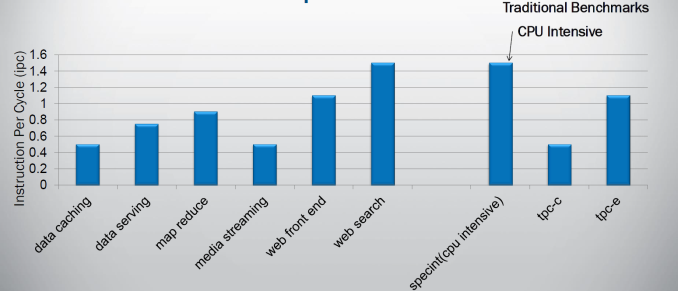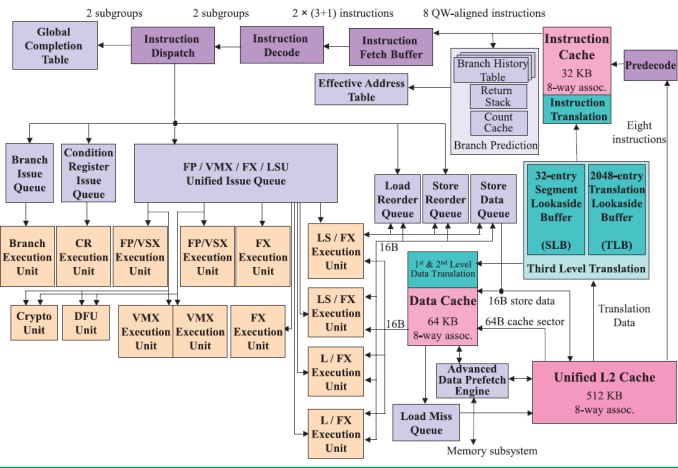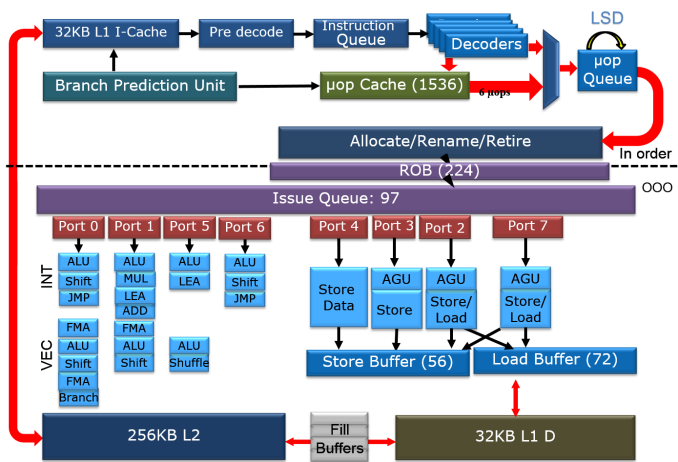Assessing IBM's POWER8, Part 1: A Low Level Look at Little Endian
by Johan De Gelas on July 21, 2016 8:45 AM ESTInside the Beast(s)
When the POWER8 was first launched, the specs were mind boggling. The processor could decode up to 8 instructions, issue 8 instructions, and execute up to 10 and all this at clockspeed up to 4.5 GHz. The POWER8 is thus an 8-way superscalar out of order processor. Now consider that
- The complexity of an architecture generally scales quadratically with the number of "ways" (hardware parallelism)
- Intel's most advanced architecture today - Skylake - is 5-way
and you know this is a bold move. If you superficially look at what kind of parallelism can be found in software, it starts to look like a suicidal move. Indeed on average, most modern CPU compute on average 2 instructions per clockcycle when running spam filtering (perlbench), video encoding (h264.ref) and protein sequence analyses (hmmer). Those are the SPEC CPU2006 integer benchmarks with the highest Instruction Per Clockcycle (IPC) rate. Server workloads are much worse: IPC of 0.8 and less are not an exception.
It is clear that simply widening a design will not bring good results, so IBM chose to run up to 8 threads simultaneously on their core. But running lots of threads is not without risk: you can end up with a throughput processor which delivers very poor performance in a wide range of applications that need that single threaded speed from time to time.
The picture below shows the wide superscalar architecture of the IBM POWER8. The image is taken from the white paper "IBM POWER8 processor core architecture", written by B. Shinharoy and many others.
The POWER8+ will have very similar microarchitecture. Since it might have to face a Skylake based Xeon, we thought it would be interesting to compare the POWER8 with both Haswell/Broadwell as Skylake.
The second picture is a very simplified architecture plan that we adapted from an older Intel Powerpoint presentation about the Haswell architecture, to show the current Skylake architecture. The adaptations were based on the latest Intel optimization manuals. The Intel diagram is much simpler than the POWER8's but that is simply because I was not as diligent as the people at IBM.
It is above our heads to compare the different branch prediction systems, but both Intel and IBM combine several different branch predictors to choose a branch. Both make use of a very large (16 K entries) global branch history table. Both processors scan 32 bytes in advance for branches. In case of IBM this is exactly 8 instructions. In case of Intel this is twice as much as it can fetch in one cycle (16 Bytes).
On the POWER8, data is fetched from the L2-cache and then predecoded into the L1-cache. Predecoding includes adding branch, exception, and grouping. This makes sure that predecoding is out the way before the actual computing ("Von Neuman Cycle") starts.
In Intel Haswell/Skylake, instructions are only predecoded after they are fetched. Predecoding performs macro-op fusion: fusing two x86 instructions together to save decode bandwidth. Intel's Skylake has 5 decoders and up to 5 µop instructions are sent down the pipelines. The current Xeon based upon Broadwell has 4 decoders and is limited to 4 instructions per clock. Those decoded instructions are sent into a µ-op cache, which can contain up to 1536 instructions (8-way), about 100 bits wide. The hitrate of the µop cache is estimated at 80-90% and up to 6 µops can be dispatched in that case. So in some situations, Skylake can run 6 instructions in parallel but as far as we understand it cannot sustain it all the time. Haswell/Broadwell are limited to 4. The µop cache can - most of the time - reduce the branch misprediction penalty from 19 to 14.
Back to the POWER8. Eight instructions are sent to the IBM POWER8 fetch buffer, where up 128 instructions can be held for two thread(s). A single thread can only use half of that buffer (64 instructions). This method of allocation gives each of two threads as much resources as one (i.e. no sharing), which is one of the key design philosophies for the POWER8 architecture.
Just like in the x86 world, the decoding unit breaks down the more complex RISC instructions into simpler internal instructions. Just like any modern Intel CPU, the opposite is also possible: the POWER8 is capable of fusing some combinations of 2 adjacent instructions into one instruction. Saving internal bandwidth and eliminating branches is one of the way this kind of fusion increases performances.
Contrary to the Intel's unified queue, the IBM POWER has 3 different issue queues: branch, condition register, and the "Load/Store/FP/Integer" queue. The first two can issue one instruction per clock, the latter can send off 8 instructions, for a combined total of 10 instructions per cycle. Intel's Haswell-Skylake cores can issue 8 µops per cycle. So both the POWER8 and Intel CPU have more than ample issue and execution resources for single threaded code. More than one thread is needed to really make use of all those resources.
Notice the difference in focus though. The Intel CPU has half of the load units (2), but each unit has twice the bandwidth (256 bit/cycle). The POWER8 has twice the amount of load units (4), but less bandwidth per unit (128 bit per cycle). Intel went for high AVX (HPC) performance, IBM's focus was on feeding 2 to 8 server threads. Just like the Intel units, the LSUs have Address Generation Units (AGUs). But contrary to Intel, the LSUs are also capable of doing simple integer calculations. That kind of massive integer crunching power would be a total waste on the Intel chip, but it is necessary if you want to run 8 threads on one core.













124 Comments
View All Comments
zodiacfml - Thursday, July 21, 2016 - link
Like a good TV series, I can't wait for the next episode.aryonoco - Friday, July 22, 2016 - link
OK, this is literally why Anandtech is the best in the tech journalism industry.There is nowhere else on the net that you can find a head to head comparison between POWER and Xeon, and unless you work in the tech department of a Fortune 500 company, this information has just not been available, until now.
Johan, thank you for your work on this article. I did give you beef in your previous article about using LE Ubuntu but I concede your point. Very happy to you are writing more for Anandtech these days.
Xeons really need some competition. Whether that competition comes from POWER or ARM or Zen, I am happy to see some competition. IBM has big plans for POWER9. Hopefully this is just the start of things to come.
JohanAnandtech - Friday, July 22, 2016 - link
Thanks! it is very exciting to perform benchmarks that nobody has published yet :-).In hindsight, I have to admit that the first article contained too few benchmarks that really mattered for POWER8. Most of our usual testing and scripting did not work, and so after lot of tinkering, swearing and sweat I got some benchmarks working on this "exotic to me" platform. The contrast between what one would expect to see on POWER8 and me being proud of being able to somewhat "tame the beast" could not have been greater :-). In other words, there was a learning curve.
tipoo - Friday, July 22, 2016 - link
I found it very interesting as well and would certainly not mind seeing more from this space, like maybe Xeon Phi and SPARC M7jospoortvliet - Tuesday, July 26, 2016 - link
Amen. But, to not ask to much, just the prospect of part 2 of the Power benchmark is already super exciting. Yes, the Internetz need more of this!Daniel Egger - Friday, July 22, 2016 - link
Not quite sure what the Endianess of a systems adds to the competitive factor. Maybe someone could elaborate why it is so important to run a system in LE?ZeDestructor - Friday, July 22, 2016 - link
Not much, really, with the compilers being good and all that.Really, it's quite clearly there just for some excellent alliteration.
JohanAnandtech - Friday, July 22, 2016 - link
Basically LE reduces the barrier for an IBM server being integrated in x86 dominated datacenter.see https://www.ibm.com/developerworks/community/blogs...
Just a few reasons:
"Numerous clients, software partners, and IBM’s own software developers have told us that porting their software to Power becomes simpler if the Linux environment on Power supports little endian mode, more closely matching the environment provided by Linux on x86. This new level of support will *** lower the barrier to entry for porting Linux on x86 software to Linux on Power **."
"A system accelerator programmer (GPU or FPGA) who needs to share memory with applications running in the system processor must share data in an pre-determined endianness for correct application functionality."
Daniel Egger - Friday, July 22, 2016 - link
While correct in theory, this hasn't been a problem for the last 20 years. People are used to using BE on PPC/POWER, the software, the drivers and the infrastructure are very mature (as a matter of fact it was my job 15 years ago to make sure they are). PPC/POWER actually have configurable endianess so if someone wanted to go LE earlier it would have easily been possible but only few ever attempted that stunt; so why have the big disruption now?KAlmquist - Friday, July 22, 2016 - link
I assume that this is about selling POWER boxes to companies that currently run all x86 servers, and have a bunch of custom software that they might be willing to recompile. If the customer has to spend a bunch of time fixing endian dependencies in his software in order to get it to work on POWER, it will probably be less expensive for them to simply stick with x86.